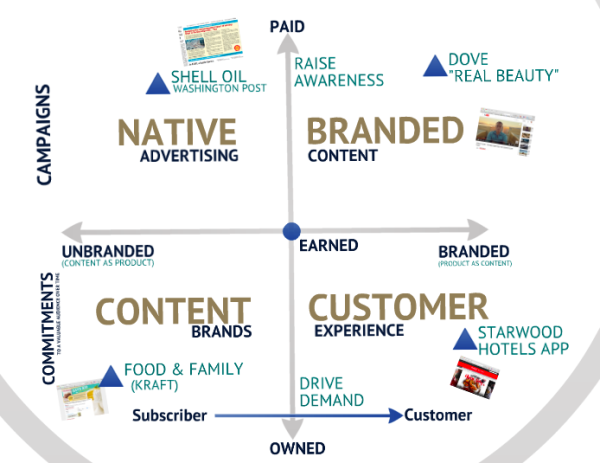
I can’t help but think about this lyric these days:
“As I walked on
Through troubled times
My spirit gets so downhearted sometimes
So where are the strong
And who are the trusted?
And where is the harmony?
Sweet harmony.
’Cause each time I feel it slippin’g away, just makes me wanna cry.
What’s so funny ’bout peace love and understanding? Ohhhh
What’s so funny ’bout peace love and understanding?”
– Nick Lowe’s (What’s So Funny A’Bout) Peace, Love, and Understanding made famous by singer Elvis Costello
One of the non-harmonious things that we’re seeing a lot of these days is a separation of approaches when it comes to using content strategically for marketing purposes. Primarily, you’ve got content marketing, native advertising, and branded content. You even have terms like branded entertainment, content selling, and (I’m not even making this up) content advertising.
To be crystal clear – with the exception of this content advertising thing – all of these content-focused methods have productive uses in the business to a varying degree. But how are they related? How do you know when to use each one? Some smart people have been trying to make sense of the delineation between approaches.
Content Marketing – It’s Going to Get Weird
Ryan Skinner, senior analyst with Forrester Research recently released a report called Don’t Confuse Media-Led and Customer-Led Content Marketing. In it, he details some of the key differences between what we would certainly call content marketing and branded content.
I’ve been talking with the wonderful Andrew Davis about this for some months, and he came up with a concept called The Content Marketing Quadrant. I think this is a really straightforward way to look at the various offshoots of content marketing. (Andrew also recorded this video to explain it.)

Andrew also recently had an interesting debate with Justin Kirby, vice president of Tenthwave and curator of Best of Branded Content Marketing, on branded content vs. content brands. Justin, who outlined his point of view and the debate here, says they both agree with the following:
(Andrew’s) not saying that content marketing is necessarily always better than other tactics, solutions, etc., only that we’re now at the stage where the term could become meaningless unless there’s an explanation about what’s different about it.
As for us at CMI, we’ve been giving the difference between these approaches some thought for a while – and communicating how they differ is a work in progress. We certainly cover these on our weekly podcast, This Old Marketing. And there is a lot of interest in this topic from our readers. Joe Pulizzi’s recent explanations (ahem, rants) about native advertising and branded content have both received a lot of traffic and interest.
The most recent iteration of this discussion is a model I call the Strategic Content Marketing Spectrum. This is a white board that resonates pretty well with our advisory clients, so I created a video to share it with you.
Instead of simply defining the often-bandied terms, I put each in the spectrum of all marketing and answer the most common questions you may grapple with such as:
Why content?
Is your content’s first purpose to bolster your brand? Or is its first purpose to deliver value, independent of your brand, to a prospect?
Click to enlarge
What is the measurable goal?
Does your content seek to generate audience and subscribers? Is it to win the business? Or is your content created to grow your customer relationships?
Click to enlarge
What approach shall you take in creating content?
This is the heart of the conversation. What’s the right approach for your business?
- Are you building content as a product that you want to drive value and build subscribers?
- Are you creating content to pull audience into owned media through paid promotion?
- Are you trying to persuade your audience to make a decision?
- Are you looking to create content that enhances the experience?

How does the creation of it differ?
Click to enlarge
There are two ends of the spectrum. Are you looking to create content as product in which the brand creates separate content brands to deliver value and ultimately build subscribers. Or, do you want to create a new product or service that expresses itself as if it were content?
What is the potential outcome for the business?
Click to enlarge
By knowing your purpose, you can better see where your content fits on the spectrum and develop the right content to help in achieving your goals and move your business forward.
While all of these questions are summarized in the graphics, you’ll find it even more helpful to take 12 minutes to watch the accompanying video where I explain as I create this spectrum and offer examples to illustrate how brands are using these terms. It’s far from perfect – but as we evolve our own understanding of how businesses can use content for business efficacy, we think the broader tent of content marketing as an approach really can cover all of these tactical uses of content. All of them have the potential to add value to the business – it’s just a matter of how.
I’d really appreciate your take on this. Does it help clarify the differences among content marketing, native advertising, and branded content? What questions do you have? Do you look at this differently?
Grow your content marketing strategic skills with the help of CMI’s Chief Strategy Officer Robert Rose. Sign up for our free weekly newsletter in which he shares his unique perspective exclusively for our subscribers.
Cover image by Joseph Kalinowski/Content Marketing Institute





